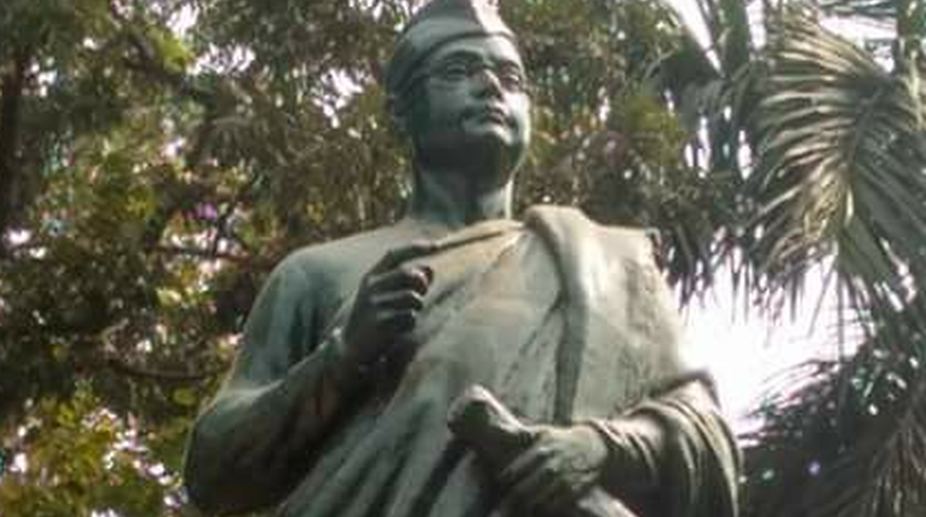On 17 October, at a modest gathering at Hojai in central Assam, a group of patriots belonging to the Netaji Subhas Chandra Mission was given a rousing reception after being taken in a procession. They had come from Kolkata to celebrate the 75th foundation day of the Provisional Azad Hind government and pay their homage to India’s thousands of known and unknown freedom fighters who laid down their lives at Moirang, 32 km from Imphal, where on 14 April 1944 the Indian National Army had hoisted the Indian National flag.
The INA (also known as the Azad Hind Fauj) was formed by patriotic Indian nationals in 1942 with the objective of liberating India from the British colonial rule. Supreme leader of the INA Subhas Chandra Bose also headed the Provisional Government of Free India (in exile).
Advertisement
Netaji announced the formation of free Indian government in exile at Cathay Cinema Hall in Singapore on 21 October 1943. Two days later he declared war against Britain with Japanese support and called it the final struggle for Indian independence.
“Now that the dawn of freedom is at hand, it is the duty of the Indian people to set up a provisional government of their own, and launch the last struggle under the banner of that government,” pronounced Netaji, adding “as all the Indian leaders were in prison and the people at home totally disarmed, it was neither possible to set up the provisional government within India nor to launch an armed struggle under its aegis.” Formed in 1942 with the motto of Ittehad, Itmad aur Qurbani (unity, faith and sacrifice), the INA comprised over 40,000 soldiers, who fought valiantly against the British imperialist forces.
Netaji became INA’s supreme commander in 1943 and undertook a ground-breaking march towards Indian Territory from Burmese soil with the aim of achieving independence. Soon after crossing the Burmese border, Netaji raised the Indian national tri-colour flag at Moirang symbolising the liberation of a portion of Indian soil from the British.
They then marched towards Imphal and Kohima but lost the battle against the colonial forces and retreated to Burma. The Hojai meeting also resolved to appeal to the Union government to preserve all Indian testimonials in Burma (now Myanmar). It is apprehended that as Myanmar is changing from a military-ruled country to a quasi-democracy, the ongoing development process might destroy all historical monuments in that country.
That country in general and particularly Yangon (earlier Rangoon) now attracts investments from various western agencies in its real-estate sector. The apprehension is that the rampant developmental activities in Yangon might lead to the destruction of many heritage buildings related to India’s freedom struggle there.
The question arises whether the then INA headquarters in Yangon along with other monuments in the former Burmese capital can be preserved. This writer, while on a visit to Yangon in 2005, was unable to locate the INA building nearby the splendid Rangoon railway station in the downtown area.
The country then was under the grip of general Than Shwe and the people were scared of talking to strangers. Moreover, Netaji was a close friend of General Aung San, the father of Burmese pro-democracy icon Suu Kyi. The friendship between Netaji and Burma’s independence hero was also reflected in cordial relationships between the INA and the Burmese National Army.
The military rulers were scared of Suu Kyi as a catalyst of change in Burma and hence they even did not pay due respect to General Aung San, who was assassinated just a few days before Burma achieved independence in 1948. As there was a ban on talking about Suu Kyi in public places, it had indirect negative implications on Netaji- related monuments as well.
Then in house-arrest but now in power, Suu Kyi can help in restoring the monuments in Myanmar related to India’s freedom movement, commented some speakers at the Hojai meeting, adding that both the countries should maintain cordial bilateral relationships in various sectors like tourism, IT, trade and commerce. Statistics reveal that the Myanmar construction industry has increased tremendously over the last few years.
Supported by Naypyidaw’s initiative in an improved political atmosphere, the flow of foreign direct investment on various sectors, like the real estate, infrastructure, energy projects et al is going up. Burmese media reports suggest that some non-government organisations, like the Yangon Heritage Trust, were trying to conserve the city’s historic buildings from the clutches of land-grabbers. But in the absence of any legal protection guidelines, the trust found it difficult to convince the federal government in Naypyidaw.
Local media outlets, even though enjoying freedom to some extent in recent time, prefer to remain silent about any historical monuments related to Netaji and the INA. On the other hand, no mainstream Indian newspapers or satellite news channels have full-time correspondents in Yangon.
One is not sure whether or not the INA building still stands in the historic city. Lately, however, during his visit to Myanmar, Prime Minister Narendra Modi proposed setting up of an INA memorial in the country with the aim of paying respect to the martyrs. Addressing the Indian diaspora in Yangon on 7 September last year, Modi mentioned about Netaji’s clarion call, “Give me blood and I will give you freedom” He said for Mahatma Gandhi, Bal Gangadhar Tilak and Bahadur Shah Zafar among others, Burma was their second home after leaving India during the freedom struggle.
He also hoped that both New Delhi and Naypyidaw would work together for a survey to find out ways for an INA memorial there. The Hojai meeting also decided to appeal to the state government to erect a life-size statue of Netaji along with Assam’s first premier Gopinath Bordoloi, in front of the state Secretariat to commemorate Netaji’s moral support to the then Bordoloi government in a critical phase of events.
Another resolution, supported by everyone, was to prohibit anyone in India to assume the title of Netaji except Subhas Chandra Bose. Mentioning about a north Indian political leader (read Mulayam Singh Yadav), whom the followers often term as Netaji, the meeting urged everyone to avoid such address in future, so that Netaji remains synonymous with Bose like Bapu to Gandhi.
(The writer is the Guwahati-based Special Representative of The Statesman.)











